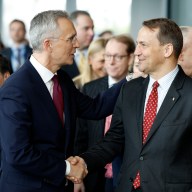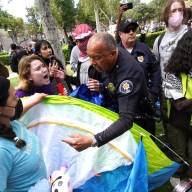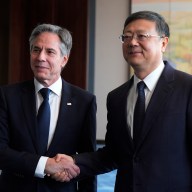KANDAHAR, Afghanistan – The United States is sending an additional 30,000 troops to Afghanistan in the hopes of breaking an insurgency that has engulfed the country’s southern regions, where Canadian troops have been holding Kandahar city.
President Barack Obama outlined a new strategy for U.S. forces that included a military surge, a focus on improving civilian institutions and diplomatic pressure on Pakistan.
“We must reverse the Taliban’s momentum,” he said in the speech from the West Point Military Academy in New York.
“And we must strengthen the capacity of Afghanistan’s security forces and government.”
American soldiers gathered around television screens at Kandahar Airfield to watch the highly anticipated speech, though it failed to bump a hockey game between the Montreal Canadiens and Toronto Maple Leafs broadcast near the Canadian barracks.
The speech aired at 5:30 a.m., local time, in Afghanistan and is expected to prompt an official reaction from Canadian commanders later Wednesday.
Though he didn’t specifically mention Kandahar, where most of Canada’s 2,850 troops are based, officials say the bulk of the American reinforcements will be posted to southern Afghanistan.
In an effort to regain the initiative in Kandahar, NATO commanders are putting Canada’s military command in charge of the tactically vital Arghandab district north of Kandahar city.
As a result, two full battalions of troops already in the country – one American, the other Afghan – will come under the control of Brig. Gen. Dan Menard, the commander of the Canadian contingent known as Task Force Kandahar, by the new year.
“You’ll get all these guys together focused on Arghandab under the command of Dan Menard,” said Brig. Gen. Frederick Hodges, director of operations for NATO’s southern command.
“I think that’s a significant manifestation of the importance of that place on the city.”
Under U.S. Army Gen. Stanley McChrystal, NATO has signalled its desire to shift the focus of counter-insurgency efforts to urban areas; Kandahar has been singled out among them.
McChrystal is expected to tour NATO bases in Afghanistan on Wednesday to outline how Obama’s strategy will be implemented.
In a statement released as Obama delivered his speech, McChrystal said his main focus will be to develop the capacity of the Afghan police and army.
“We will work toward improved security for Afghanistan and the transfer of responsibility to Afghan security forces as rapidly as conditions allow,” he said.
By hastening the training of both the Afghan National Army and Afghan National Police, Obama hopes to create a sustainable security environment that will allow the U.S. to begin withdrawing its troops in 2011.
“After 18 months, our troops will begin to come home,” he said.
The timeframe coincides roughly with the planned end of the Canadian combat mission in Afghanistan.
Speaking in Ottawa, Defence Minister Peter MacKay said earlier the decisions to focus Canadian resources on Arghandab does not signal a change in direction for the mission, nor does it threaten the vaunted “model village” project in the Dand district to the south.
The model village concept, largely credited to Menard’s predecessor, Brig. Gen. Jonathan Vance, is a uniquely Canadian combination of security, development and political outreach designed to win over public support and drive out insurgents in smaller rural areas outside the city.
“The Americans have paid us an enormous compliment,” MacKay said of Canada’s added responsibilities. “They trust us. They appreciate our expertise.”
The move won’t change Canada’s mind about its own scheduled 2011 exit date, “nor does it affect our ongoing responsibility with Kandahar city” and the projects already begun, he added.
Foreign Affairs Minister Lawrence Cannon said he welcomes the increase in U.S. troops.
“We are pleased that the objectives of the U.S. policy are complementary to Canada’s own priorities,” Cannon said in a new release following Obama’s address.
“Canada has a significant civilian contingent on the ground in Afghanistan working alongside their military colleagues to ensure our programs and policies are helping the Afghan government to build a stable, democratic and self-sufficient society.”
Obama’s decision will put pressure on other NATO allies to either contribute more troops or in cases like Canada, extend existing commitments.
“I think it’ll have a positive influence on how other countries think about whether or not they should commit,” Hodges said in an interview prior to Obama’s announcement. “I personally… would love to see the Canadians stay here as long as is necessary, but I understand each nation has to make its own decisions.”
U.S. Secretary of State Hillary Clinton has already asked France for an additional 1,500 troops to add to the 3,750 already in the country. She is seeking up to 7,000 more soldiers in all from the NATO alliance.
And while Canada is slated to begin a military pullout in 2011, some say it’s not beyond the realm of possibility that Obama’s plan could influence the popular perception of the Afghan mission in Canada.
“I would suggest that if Obama had a strategy that Canadians would be at ease with, it’s not inconceivable the government would change its direction,” said Maj. Gen. (ret.) Terry Liston, a former chief of planning and development with the Canadian Armed Forces.
But Liston questioned whether an additional 30,000 troops would be enough to conduct a counter-insurgency properly, forcing the U.S. to rely on airstrikes and drone attacks that put civilians at risk.
With insufficient force levels, Obama would be hard-pressed to distinguish his military approach from his predecessor, George W. Bush, who focused on the counter-terrorism dimension.
“The extent that it seems to be a continuation of the (former U.S. secretary of defence Donald) Rumsfield approach, it’s not going to cause a rethink in Canada,” Liston said.
















